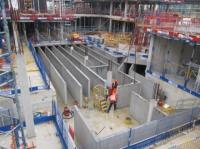 Add My Company
Add My Company
Sign In

ACP Concrete Ltd supplied and installed the precast concrete panels that form the cooling labyrinth at the £30 million Big Data Institute, which is phase 2 of the Li Ka Shing Centre for Health Information and Discovery at the University of Oxford. Funded by the UK Government and a £20 million donation from the Li Ka Shing Foundation, the building has been nominated for the BE&E awards rewarding innovation and achievement in energy efficiency in buildings across the UK.
The Big Data Institute, opening in November 2016, will be an international centre of excellence for the analysis of very large and complex biomedical data sets. Here data will be stored, analysed and processed with the aim of providing new insights into illnesses and treatments worldwide.
Central to the concept of the building designed by architects, Make, is the use of passive design, which is based on achieving energy savings without the use of a power plant or mechanical equipment, and using natural ventilation principles wherever possible. As part of this strategy a subterranean labyrinth is located beneath the lower ground floor which draws in air through the light-well and uses the thermal mass of the ground to cool it before circulating it to the main roof top plant room. This air is then distributed via a floor plenum as part of an assisted natural ventilation strategy and extracted via the atrium using the stack effect.
Mace, the main contractors for the project, employed MH Getjar Ltd, specialist reinforced concrete frame and groundwork specialists to supply and install the basement including the concrete cooling labyrinth. Getjar Ltd in turn chose ACP (Concrete) Ltd to design a precast solution for the internal baffle walls and roof within the insitu basement. The project posed challenges on a number of fronts:
- The air needs to move slowly around the labyrinth to maximise the cooling effect. To aid this the normal smooth surface of the panels was textured using a mould liner on one side and a brushed finish on the other to increase the surface area.
- Adding to the surface area in the labyrinth, the roof was constructed using interlocking prestressed concrete panel units which were mastic sealed as work progressed to ensure that no rainwater could percolate into finished areas.
- A tight programme required a vertical build sequence with resulting issues for safety of the workforce building below. A method was devised to ensure that once the roof panels had been fitted that there was no need for the installation team to go back to these areas, thus removing the risks of working in confined spaces.
- The close proximity of the baffle walls to one another meant that the usual propping during installation was not possible so ACP’s Jeremy Nash developed a system whereby the precast units were positioned over and fixed to cast-in holding down bolts, using a wall shoe arrangement, before the crane was released, thus avoiding the need for props and temporary works whilst improving safety. This required high accuracy during manufacture and precision on site but proved to be a successful innovation.
- The site was congested so deliveries were required to be ‘just in time’ and all vehicles had to meet both CLOCS and FORS requirements.
Despite these challenges the construction of the labyrinth was completed on programme and on budget to the satisfaction of all involved. The Institute is due to open in November later this year.
For more information on CONCRETE LABYRINTH CONSTRUCTED FOR BIG DATA INSTITUTE, OXFORD talk to ACP Concrete Ltd
Enquire Now
List your company on FindTheNeedle.

